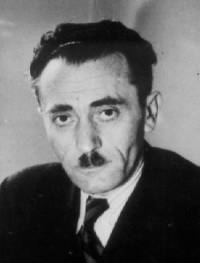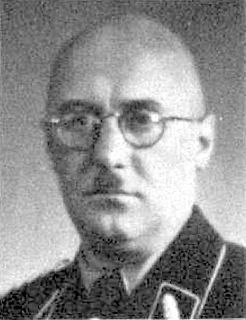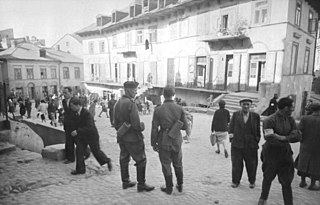The factual accuracy of part of this article is disputed. The dispute is about the confirmation of Rosenberg's personal history during World War II, from reliable third-party sources .(December 2013) (Learn how and when to remove this template message) |
Sol Rosenberg | |
|---|---|
| Born | February 2, 1926 |
| Died | January 30, 2009 (aged 82) |
| Resting place | Jewish Cemetery in Monroe, Louisiana |
| Occupation | Businessman; Philanthropist |
| Spouse(s) | Tola Barron Rosenberg (married c. 1946-2006, her death) |
| Children | Joe Fred Rosenberg (deceased) Jackie Rosenberg |
| Notes | |
(1) Rosenberg was a businessman and philanthropist in Monroe, Louisiana, determined to tell the Holocaust story through his charter membership in the national Holocaust Museum and his biography Sol's Story: A Triumph of the Human Spirit. (2) Rosenberg was a leader among the small Jewish congregation in Monroe dedicated to the restoration of the Jewish Cemetery, where he and his wife are interred. | |
Sol Rosenberg (February 2, 1926 – January 30, 2009) was a Polish-born American businessman and philanthropist. A Jewish survivor of the German Nazi death and concentration camps, he settled after World War II in Monroe in Ouachita Parish in northeastern Louisiana.

Poland, officially the Republic of Poland, is a country located in Central Europe. It is divided into 16 administrative subdivisions, covering an area of 312,696 square kilometres (120,733 sq mi), and has a largely temperate seasonal climate. With a population of approximately 38.5 million people, Poland is the sixth most populous member state of the European Union. Poland's capital and largest metropolis is Warsaw. Other major cities include Kraków, Łódź, Wrocław, Poznań, Gdańsk, and Szczecin.

The United States of America (USA), commonly known as the United States or America, is a country composed of 50 states, a federal district, five major self-governing territories, and various possessions. At 3.8 million square miles, the United States is the world's third or fourth largest country by total area and is slightly smaller than the entire continent of Europe's 3.9 million square miles. With a population of over 327 million people, the U.S. is the third most populous country. The capital is Washington, D.C., and the largest city by population is New York. Forty-eight states and the capital's federal district are contiguous in North America between Canada and Mexico. The State of Alaska is in the northwest corner of North America, bordered by Canada to the east and across the Bering Strait from Russia to the west. The State of Hawaii is an archipelago in the mid-Pacific Ocean. The U.S. territories are scattered about the Pacific Ocean and the Caribbean Sea, stretching across nine official time zones. The extremely diverse geography, climate, and wildlife of the United States make it one of the world's 17 megadiverse countries.

Business is the activity of making one's living or making money by producing or buying and selling products. Simply put, it is "any activity or enterprise entered into for profit. It does not mean it is a company, a corporation, partnership, or have any such formal organization, but it can range from a street peddler to General Motors."
After the German invasion of Poland of 1939, Rosenberg lived in the Warsaw Ghetto set up by the Nazi occupiers of Poland. The German Nazi regime sent his parents and two sisters to their deaths in 1942, but Rosenberg was one of the very few to escape from the death camp at Treblinka; he returned to Warsaw, where he participated in the Warsaw Ghetto Uprising. Rosenberg was then sent to the Dachau concentration camp, where he was liberated by the Allied Powers after the final overthrow of the Nazi regime. [1]

The Warsaw Ghetto was the largest of all the Jewish ghettos in German-occupied Europe during World War II. It was established by the German authorities in the Muranów neighborhood of the Polish capital between October and November 16, 1940; within the new General Government territory of German-occupied Poland. There were over 400,000 Jews imprisoned there, at an area of 3.4 km2 (1.3 sq mi), with an average of 9.2 persons per room, barely subsisting on meager food rations. From the Warsaw Ghetto, Jews were deported to Nazi concentration camps and mass-killing centers. In the summer of 1942 at least 254,000 Ghetto residents were sent to the Treblinka extermination camp during Großaktion Warschau under the guise of "resettlement in the East" over the course of the summer. The ghetto was demolished by the Germans in May 1943 after the Warsaw Ghetto Uprisings which had temporarily halted the deportations. The total death toll among the Jewish inhabitants of the Ghetto is estimated to be at least 300,000 killed by bullet or gas, combined with 92,000 victims of rampant hunger and hunger-related diseases, the Warsaw Ghetto Uprising, and the casualties of the final destruction of the Ghetto.

Nazi Germany is the common English name for Germany between 1933 and 1945, when Adolf Hitler and his Nazi Party (NSDAP) controlled the country through a dictatorship. Under Hitler's rule, Germany was transformed into a totalitarian state that controlled nearly all aspects of life via the Gleichschaltung legal process. The official name of the state was Deutsches Reich until 1943 and Großdeutsches Reich from 1943 to 1945. Nazi Germany is also known as the Third Reich, meaning "Third Realm" or "Third Empire", the first two being the Holy Roman Empire (800–1806) and the German Empire (1871–1918). The Nazi regime ended after the Allies defeated Germany in May 1945, ending World War II in Europe.

The Warsaw Ghetto Uprising was the 1943 act of Jewish resistance in the Warsaw Ghetto in German-occupied Poland during World War II to oppose Nazi Germany's final effort to transport the remaining ghetto population to Majdanek and Treblinka concentration camps. After the Grossaktion Warsaw of summer 1942, in which more than a quarter of a million Jews were deported from the ghetto to Treblinka and murdered, the remaining Jews began to build bunkers and smuggle weapons and explosives into the ghetto. The left-wing Jewish Combat Organization (ŻOB) and right-wing Jewish Military Union (ŻZW) formed and began to train. However, only the ŻZW received logistical support from the similarly right-leaning Polish Home Army. A small resistance effort to another roundup in January 1943 was partially successful and spurred the Polish groups to support the Jews in earnest.
In Poland, Rosenberg met his wife, the former Tola Baron (June 22, 1924 – January 12, 2006). The couple emigrated to Louisiana in 1949 and thereafter settled in Monroe where they started from scratch Sol's Pipe and Steel Company. [1]
Rosenberg was involved in community affairs and charitable works, being a charter founder of the United States Holocaust Memorial Museum in Washington, D.C., and the Holocaust Museum Houston. He was a member of the Monroe Chamber of Commerce and supported the Booster Club at the University of Louisiana at Monroe. In 2006, he was awarded the Kitty DeGree Lifetime Business Achievement Award. He played golf at the Bayou Desiard Country Club in Monroe, where he made a hole in one at the age of eighty-one. [2]

The United States Holocaust Memorial Museum (USHMM) is the United States' official memorial to the Holocaust. Adjacent to the National Mall in Washington, D.C., the USHMM provides for the documentation, study, and interpretation of Holocaust history. It is dedicated to helping leaders and citizens of the world confront hatred, prevent genocide, promote human dignity, and strengthen democracy.

Washington, D.C., formally the District of Columbia and commonly referred to as Washington or D.C., is the capital of the United States. Founded after the American Revolution as the seat of government of the newly independent country, Washington was named after George Washington, first President of the United States and Founding Father. As the seat of the United States federal government and several international organizations, Washington is an important world political capital. The city is also one of the most visited cities in the world, with more than 20 million tourists annually.

The Holocaust Museum Houston, the fourth largest Holocaust memorial museum in the United States, is located in the Houston Museum District in Houston, Texas and was opened in 1996.
Rosenberg contributed to youth athletics and the reconstruction of the Jewish Cemetery in Monroe. His friend Jay Marx, a Jewish former member of the Monroe City Council, characterized Rosenberg's life as "the American dream. He found his way in a new country and reaped the benefits of this country. ... He didn't take for granted anything, and he shared plenty. I think all of us will certainly regret his loss but will admire his life." [1]
"My father was kind of like a Will Rogers in reverse; he never met a man who didn't like him," said his second oldest son, Jackie Rosenberg, in an interview with the Monroe News Star . [1] The senior Rosenberg remained active in the family's business, Sol's Pipe and Steel, an international company, until he was struck by cancer. [1]

William Penn Adair Rogers was an American stage and motion picture actor, vaudeville performer, American cowboy, humorist, newspaper columnist, and social commentator from Oklahoma. He was a Cherokee citizen born in the Cherokee Nation, Indian Territory.

Cancer is a group of diseases involving abnormal cell growth with the potential to invade or spread to other parts of the body. These contrast with benign tumors, which do not spread to other parts of the body. Possible signs and symptoms include a lump, abnormal bleeding, prolonged cough, unexplained weight loss and a change in bowel movements. While these symptoms may indicate cancer, they may have other causes. Over 100 types of cancers affect humans.
Rosenberg died at his Monroe residence. In addition to his son Jackie and his wife, Diane, Rosenberg was survived by four other children, Joe Fred Rosenberg (1947-2018), a trained pharmacist who established Interstate Metals in Monroe, and his wife, Pamela Jean Rosenberg; [3] Herman Rosenberg, Jeannie Wermuth and her husband, Gary, and Terri Rosenberg, and twelve grandchildren. [2] Services were held on February 1, 2009, the day before what would have been Rosenberg's 83rd birthday, at the Reform Judaism synagogue, Temple B'nai Israel, in Monroe. [4] Interment was at the Jewish Cemetery. [2]
Sol's Story: A Triumph of the Human Spirit by Richard B. Chardkoff, a ULM historian, tells the story of Rosenberg's trials and triumphs. [5] His obituary quotes him, accordingly: "I love the United States. I'm a citizen. I'm proud to be an American, and I'm a good American. Nowhere in the whole world did I find happiness. I find happiness in America." [2]















